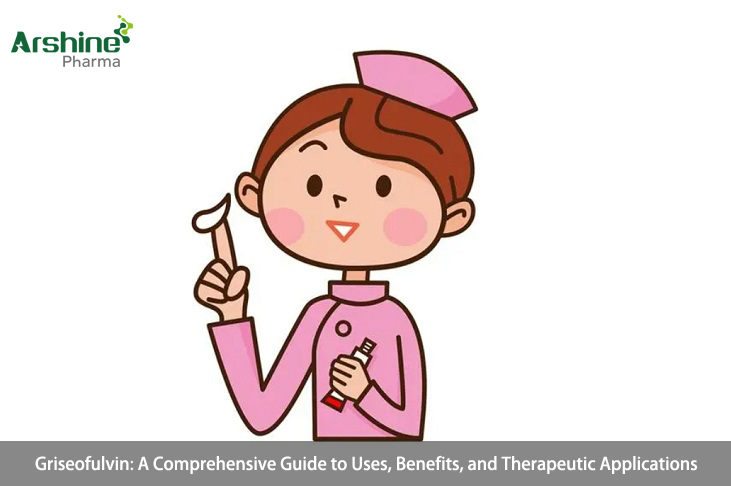
Introduction: Griseofulvin, a potent antifungal medication, holds a significant role in the treatment of various fungal infections affecting the skin, hair, and nails. This article serves as a comprehensive resource, exploring the uses, benefits, and therapeutic implications of Griseofulvin in managing fungal diseases across different medical contexts.
Understanding Griseofulvin: Griseofulvin belongs to the class of antifungal agents known as griseofulvins, derived from the mold Penicillium griseofulvum. It exerts its antifungal effects by inhibiting fungal cell division and disrupting the synthesis of fungal cell walls, thereby preventing the growth and spread of dermatophyte fungi responsible for causing skin, hair, and nail infections. Griseofulvin is available in oral formulations and is commonly prescribed for the treatment of dermatophytosis, also known as ringworm or tinea infections.
Applications in Disease Treatment: Griseofulvin finds widespread use in the treatment of various fungal infections, including:
-
Tinea Infections: Tinea infections, caused by dermatophyte fungi belonging to the genera Trichophyton, Microsporum, and Epidermophyton, manifest as superficial fungal infections affecting the skin, hair, and nails. Griseofulvin is highly effective against dermatophyte infections, including tinea corporis (ringworm of the body), tinea cruris (jock itch), tinea capitis (scalp ringworm), tinea pedis (athlete's foot), and tinea unguium (onychomycosis or nail fungus). Its fungistatic action inhibits the growth and reproduction of dermatophytes, allowing for resolution of infection and restoration of normal tissue integrity.
-
Onychomycosis: Onychomycosis, a common fungal infection of the nails, is often challenging to treat due to the slow growth rate of nails and the difficulty of antifungal agents penetrating the nail plate. Griseofulvin is effective in the management of onychomycosis, particularly when caused by dermatophyte fungi. By targeting the site of infection within the nail matrix, Griseofulvin helps eradicate fungal pathogens and promote the growth of healthy nail tissue, resulting in clinical improvement and resolution of onychomycosis over time.
-
Superficial Dermatophytoses: Superficial dermatophytoses, such as tinea versicolor (pityriasis versicolor) and tinea corporis gladiatorum (ringworm in wrestlers), are fungal infections characterized by discolored patches, scales, or plaques on the skin. Griseofulvin is effective against these superficial fungal infections, exerting its antifungal action directly on the affected skin surface. Topical formulations of Griseofulvin may be employed for localized treatment of superficial dermatophytoses, providing symptomatic relief and promoting resolution of fungal lesions.
-
Severe or Recalcitrant Infections: In cases of severe or recalcitrant fungal infections, where topical antifungal treatments are ineffective or impractical, oral Griseofulvin may be prescribed for systemic therapy. Oral administration allows for systemic distribution of Griseofulvin throughout the body, reaching target tissues inaccessible to topical agents and providing comprehensive antifungal coverage. Systemic Griseofulvin therapy is indicated for severe or widespread dermatophytosis, particularly in immunocompromised patients or those with chronic or refractory infections.
-
Veterinary Use: Griseofulvin is also utilized in veterinary medicine for the treatment of fungal infections in animals, including dogs, cats, and horses. Veterinary formulations of Griseofulvin may be administered orally or topically to treat dermatophytosis, onychomycosis, and other fungal infections affecting companion animals and livestock. By targeting fungal pathogens in animals, Griseofulvin helps alleviate symptoms, prevent transmission of infection, and improve overall animal health and welfare.
-
Research and Development: Beyond its clinical applications, Griseofulvin continues to be a subject of research and development for its potential therapeutic benefits in other medical conditions. Emerging studies have explored the antitumor, immunomodulatory, and anti-inflammatory properties of Griseofulvin, suggesting potential applications in cancer therapy, autoimmune diseases, and inflammatory disorders. Further research is needed to elucidate the mechanisms underlying these effects and evaluate the clinical efficacy of Griseofulvin in diverse therapeutic contexts.
Conclusion: Griseofulvin stands as a cornerstone in the treatment of fungal infections, offering a potent and effective solution for dermatophytosis, onychomycosis, and other superficial fungal infections. Its broad spectrum of antifungal activity, systemic distribution, and veterinary applications highlight its versatility and importance in clinical practice and veterinary medicine. By understanding the uses and benefits of Griseofulvin, healthcare professionals and veterinarians can optimize its utilization and improve outcomes for patients and animals affected by fungal diseases.
